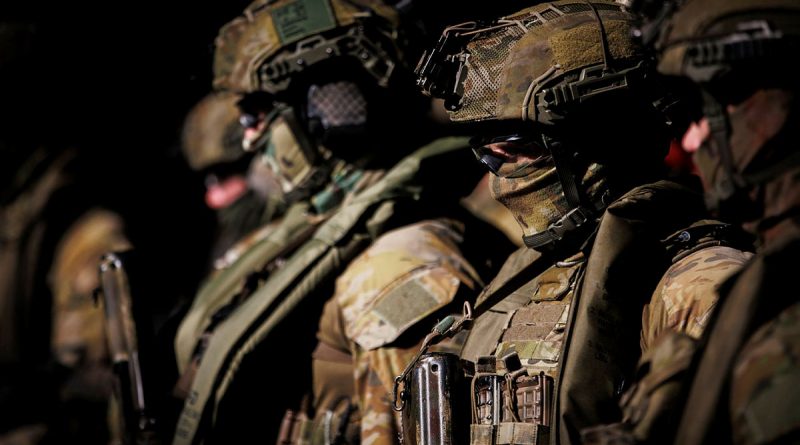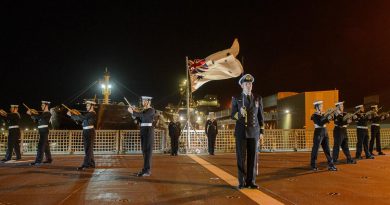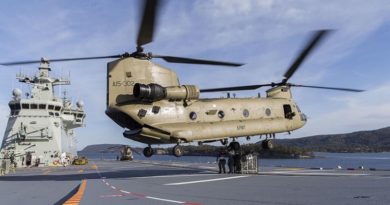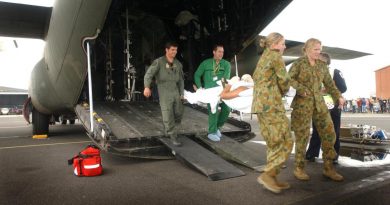An amphibious force to be reckoned with

The 2022 Sea Series has come to a close with the completion of Exercise Sea Raider.
CAPTION: Soldiers from the 1st Battalion, The Royal Australian Regiment, prepare to conduct wet and dry exercise rehearsals, during Exercise Sea Raider 2022 near Cowley Beach, Queensland. Story by Captain Joanne Leca. Photo by Corporal Cameron Pegg.
An opportunity for the Australian Amphibious Force (AAF) to showcase its capabilities, Exercise Sea Raider involved a joint force comprising the Royal Australian Navy’s HMAS Adelaide and an embarked force from Army.
The Army contingent consisted of infantry, armoured vehicles, protected mobility, artillery, attack and lift aviation, unmanned aerial systems, military working dogs as well as logistics vehicles, vessels and personnel.
During the exercise, hundreds of ADF troops successfully conducted a night-time amphibious assault from Adelaide onto Cowley Beach training area near Townsville.
The assault included Boxer combat reconnaissance vehicles in the first wave, M777 155mm howitzers underslung beneath CH-47 Chinooks and protected mobility vehicles.
Designed to rapidly build up combat power ashore, the assault was supported by small boats, and LCM-8 and LARC landing craft.
To ensure maximum flexibility for the force during the assault, a Tiger helicopter provided overwatch, reconnaissance, commentary and, if necessary, precision fires.
The exercise established new milestones with the increased integration of live ammunition into previously blank-fire training scenarios, the incorporation of unmanned aerial systems and the tactical employment of the Boxer.

CAPTION: Soldiers from 10th Force Support Battalion await the arrival of a Boxer.
The stage was set when patrols from the joint pre-landing force (based on 2nd Battalion, Royal Australian Regiment) inserted at extended range and remained undetected while they provided intelligence back to the AAF as it steamed towards the area.
This intelligence enabled the assault force (based on 1st Battalion, Royal Australian Regiment) to land and move rapidly inland to clear a series of simulated enemy positions using combined arms manoeuvre and attack.
Throughout these actions, the remainder of the AAF on board Adelaide continued to provide support with attack aviation, resupply and command and control.
Commander Landing Force Colonel Douglas Pashley said exercises like this proved the AAF was capable of projecting a range of capabilities anywhere in the region.
“It’s important for us to demonstrate to allies and friends that we continue to be a credible and reliable partner in the region, remaining committed to maintaining regional security and assisting during humanitarian disasters,” Colonel Pashley said.
A team from the Royal Australian Air Force also embarked to manage the airspace.
Squadron Leader Joshua Daish, Amphibious Air Liaison Officer for RAAF, said a high level of integration was required from each service to ensure common ground was achieved.
“There’s significant work involved in the planning process and execution,” Squadron Leader Daish said.
“In planning we must access the terrain, threat and conditions both human and environmental to ensure we have the available assets necessary to support amphibious force lodgement and maritime manoeuvre.”

CAPTION: A Boxer from the 2nd/14th Light Horse Regiment (Queensland Mounted Infantry) fires at a target.
.
.

.
.






As a former Australian Grunt, I have 2 questions.
WHERE are we practicing these landing for?
WHO are we practicing to fight against?
Unless we have an identified Enemy, we may as well train for attacking Mars, that seems just as likely a Foe.
Neutrality for Australia.
DUTY FIRST.